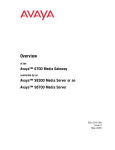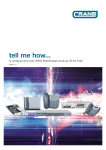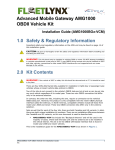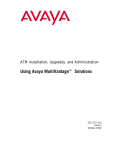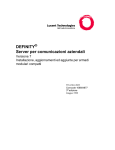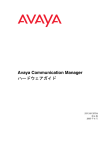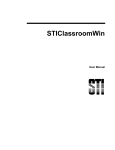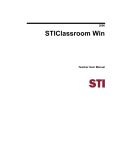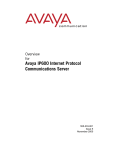Download Overview for the Avaya S8700 Media Server with Avaya G650
Transcript
Overview for the Avaya S8700 Media Server with Avaya G650 Media Gateways 555-245-204 Issue 1 November 2003 Copyright 2003, Avaya Inc. All Rights Reserved Notice Every effort was made to ensure that the information in this document was complete and accurate at the time of printing. However, information is subject to change. Warranty Avaya Inc. provides a limited warranty on this product. Refer to your sales agreement to establish the terms of the limited warranty. In addition, Avaya’s standard warranty language as well as information regarding support for this product, while under warranty, is available through the following Web site: http://www.avaya.com/support. Preventing Toll Fraud “Toll fraud” is the unauthorized use of your telecommunications system by an unauthorized party (for example, a person who is not a corporate employee, agent, subcontractor, or is not working on your company's behalf). Be aware that there may be a risk of toll fraud associated with your system and that, if toll fraud occurs, it can result in substantial additional charges for your telecommunications services. Avaya Fraud Intervention If you suspect that you are being victimized by toll fraud and you need technical assistance or support, in the United States and Canada, call the Technical Service Center's Toll Fraud Intervention Hotline at 1-800-643-2353. How to Get Help For additional support telephone numbers, go to the Avaya support Web site: http://www.avaya.com/support. If you are: • Within the United States, click the Escalation Management link. Then click the appropriate link for the type of support you need. • Outside the United States, click the Escalation Management link. Then click the International Services link that includes telephone numbers for the international Centers of Excellence. Providing Telecommunications Security Telecommunications security (of voice, data, and/or video communications) is the prevention of any type of intrusion to (that is, either unauthorized or malicious access to or use of) your company's telecommunications equipment by some party. Your company's “telecommunications equipment” includes both this Avaya product and any other voice/data/video equipment that could be accessed via this Avaya product (that is, “networked equipment”). An “outside party” is anyone who is not a corporate employee, agent, subcontractor, or is not working on your company's behalf. Whereas, a “malicious party” is anyone (including someone who may be otherwise authorized) who accesses your telecommunications equipment with either malicious or mischievous intent. Such intrusions may be either to/through synchronous (timemultiplexed and/or circuit-based) or asynchronous (character-, message-, or packet-based) equipment or interfaces for reasons of: • Utilization (of capabilities special to the accessed equipment) • Theft (such as, of intellectual property, financial assets, or toll facility access) • Eavesdropping (privacy invasions to humans) • Mischief (troubling, but apparently innocuous, tampering) • Harm (such as harmful tampering, data loss or alteration, regardless of motive or intent) Be aware that there may be a risk of unauthorized intrusions associated with your system and/or its networked equipment. Also realize that, if such an intrusion should occur, it could result in a variety of losses to your company (including but not limited to, human/data privacy, intellectual property, material assets, financial resources, labor costs, and/or legal costs). Responsibility for Your Company’s Telecommunications Security The final responsibility for securing both this system and its networked equipment rests with you - Avaya’s customer system administrator, your telecommunications peers, and your managers. Base the fulfillment of your responsibility on acquired knowledge and resources from a variety of sources including but not limited to: • • • • • • Installation documents System administration documents Security documents Hardware-/software-based security tools Shared information between you and your peers Telecommunications security experts To prevent intrusions to your telecommunications equipment, you and your peers should carefully program and configure: • Your Avaya-provided telecommunications systems and their interfaces • Your Avaya-provided software applications, as well as their underlying hardware/software platforms and interfaces • Any other equipment networked to your Avaya products TCP/IP Facilities Customers may experience differences in product performance, reliability and security depending upon network configurations/design and topologies, even when the product performs as warranted. Standards Compliance Avaya Inc. is not responsible for any radio or television interference caused by unauthorized modifications of this equipment or the substitution or attachment of connecting cables and equipment other than those specified by Avaya Inc. The correction of interference caused by such unauthorized modifications, substitution or attachment will be the responsibility of the user. Pursuant to Part 15 of the Federal Communications Commission (FCC) Rules, the user is cautioned that changes or modifications not expressly approved by Avaya Inc. could void the user’s authority to operate this equipment. Product Safety Standards This product complies with and conforms to the following international Product Safety standards as applicable: Safety of Information Technology Equipment, IEC 60950, 3rd Edition including all relevant national deviations as listed in Compliance with IEC for Electrical Equipment (IECEE) CB-96A. Safety of Information Technology Equipment, CAN/CSA-C22.2 No. 60950-00 / UL 60950, 3rd Edition Safety Requirements for Customer Equipment, ACA Technical Standard (TS) 001 - 1997 One or more of the following Mexican national standards, as applicable: NOM 001 SCFI 1993, NOM SCFI 016 1993, NOM 019 SCFI 1998 The equipment described in this document may contain Class 1 LASER Device(s). These devices comply with the following standards: • EN 60825-1, Edition 1.1, 1998-01 • 21 CFR 1040.10 and CFR 1040.11. The LASER devices operate within the following parameters: • Maximum power output: -5 dBm to -8 dBm • Center Wavelength: 1310 nm to 1360 nm Luokan 1 Laserlaite Klass 1 Laser Apparat Use of controls or adjustments or performance of procedures other than those specified herein may result in hazardous radiation exposures. Contact your Avaya representative for more laser product information. Electromagnetic Compatibility (EMC) Standards This product complies with and conforms to the following international EMC standards and all relevant national deviations: Limits and Methods of Measurement of Radio Interference of Information Technology Equipment, CISPR 22:1997 and EN55022:1998. Information Technology Equipment – Immunity Characteristics – Limits and Methods of Measurement, CISPR 24:1997 and EN55024:1998, including: • • • • • • • • • Electrostatic Discharge (ESD) IEC 61000-4-2 Radiated Immunity IEC 61000-4-3 Electrical Fast Transient IEC 61000-4-4 Lightning Effects IEC 61000-4-5 Conducted Immunity IEC 61000-4-6 Mains Frequency Magnetic Field IEC 61000-4-8 Voltage Dips and Variations IEC 61000-4-11 Powerline Harmonics IEC 61000-3-2 Voltage Fluctuations and Flicker IEC 61000-3-3 Federal Communications Commission Statement Part 15: Note: This equipment has been tested and found to comply with the limits for a Class A digital device, pursuant to Part 15 of the FCC Rules. These limits are designed to provide reasonable protection against harmful interference when the equipment is operated in a commercial environment. This equipment generates, uses, and can radiate radio frequency energy and, if not installed and used in accordance with the instruction manual, may cause harmful interference to radio communications. Operation of this equipment in a residential area is likely to cause harmful interference in which case the user will be required to correct the interference at his own expense. Avaya attests that this registered equipment is capable of providing users access to interstate providers of operator services through the use of access codes. Modification of this equipment by call aggregators to block access dialing codes is a violation of the Telephone Operator Consumers Act of 1990. REN Number For MCC1, SCC1, CMC1, G600, and G650 Media Gateways: This equipment complies with Part 68 of the FCC rules. On either the rear or inside the front cover of this equipment is a label that contains, among other information, the FCC registration number, and ringer equivalence number (REN) for this equipment. If requested, this information must be provided to the telephone company. For G350 and G700 Media Gateways: This equipment complies with Part 68 of the FCC rules and the requirements adopted by the ACTA. On the rear of this equipment is a label that contains, among other information, a product identifier in the format US:AAAEQ##TXXXX. The digits represented by ## are the ringer equivalence number (REN) without a decimal point (for example, 03 is a REN of 0.3). If requested, this number must be provided to the telephone company. For all media gateways: The REN is used to determine the quantity of devices that may be connected to the telephone line. Excessive RENs on the telephone line may result in devices not ringing in response to an incoming call. In most, but not all areas, the sum of RENs should not exceed 5.0. To be certain of the number of devices that may be connected to a line, as determined by the total RENs, contact the local telephone company. REN is not required for some types of analog or digital facilities. Means of Connection Connection of this equipment to the telephone network is shown in the following tables. For MCC1, SCC1, CMC1, G600, and G650 Media Gateways: Manufacturer’s Port Identifier FIC Code SOC/REN/ Network A.S. Code Jacks Off premises station OL13C 9.0F RJ2GX, RJ21X, RJ11C DID trunk 02RV2-T 0.0B RJ2GX, RJ21X CO trunk 02GS2 0.3A RJ21X 02LS2 0.3A RJ21X Tie trunk TL31M 9.0F RJ2GX Basic Rate Interface 02IS5 6.0F, 6.0Y RJ49C 1.544 digital interface 04DU9-BN 6.0F RJ48C, RJ48M 04DU9-IKN 6.0F RJ48C, RJ48M 04DU9-ISN 6.0F RJ48C, RJ48M 04DU9-DN 6.0Y RJ48C Part 68: Answer-Supervision Signaling Allowing this equipment to be operated in a manner that does not provide proper answer-supervision signaling is in violation of Part 68 rules. This equipment returns answer-supervision signals to the public switched network when: • answered by the called station, • answered by the attendant, or • routed to a recorded announcement that can be administered by the customer premises equipment (CPE) user. This equipment returns answer-supervision signals on all direct inward dialed (DID) calls forwarded back to the public switched telephone network. Permissible exceptions are: • A call is unanswered. • A busy tone is received. • A reorder tone is received. 120A4 channel service unit Declarations of Conformity For G350 and G700 Media Gateways: Manufacturer’s Port Identifier FIC Code SOC/REN/ Network A.S. Code Jacks Ground Start CO trunk 02GS2 1.0A RJ11C DID trunk 02RV2-T AS.0 RJ11C Loop Start CO trunk 02LS2 0.5A RJ11C 1.544 digital interface 04DU9-BN 6.0Y RJ48C Basic Rate Interface 04DU9-DN 6.0Y RJ48C 04DU9-IKN 6.0Y RJ48C 04DU9-ISN 6.0Y RJ48C 02IS5 6.0F RJ49C For all media gateways: If the terminal equipment (for example, the media server or media gateway) causes harm to the telephone network, the telephone company will notify you in advance that temporary discontinuance of service may be required. But if advance notice is not practical, the telephone company will notify the customer as soon as possible. Also, you will be advised of your right to file a complaint with the FCC if you believe it is necessary. The telephone company may make changes in its facilities, equipment, operations or procedures that could affect the operation of the equipment. If this happens, the telephone company will provide advance notice in order for you to make necessary modifications to maintain uninterrupted service. If trouble is experienced with this equipment, for repair or warranty information, please contact the Technical Service Center at 1-800-242- 2121 or contact your local Avaya representative. If the equipment is causing harm to the telephone network, the telephone company may request that you disconnect the equipment until the problem is resolved. A plug and jack used to connect this equipment to the premises wiring and telephone network must comply with the applicable FCC Part 68 rules and requirements adopted by the ACTA. A compliant telephone cord and modular plug is provided with this product. It is designed to be connected to a compatible modular jack that is also compliant. It is recommended that repairs be performed by Avaya certified technicians. The equipment cannot be used on public coin phone service provided by the telephone company. Connection to party line service is subject to state tariffs. Contact the state public utility commission, public service commission or corporation commission for information. United States FCC Part 68 Supplier’s Declaration of Conformity (SDoC) Avaya Inc. in the United States of America hereby certifies that the equipment described in this document and bearing a TIA TSB-168 label identification number complies with the FCC’s Rules and Regulations 47 CFR Part 68, and the Administrative Council on Terminal Attachments (ACTA) adopted technical criteria. Avaya further asserts that Avaya handset-equipped terminal equipment described in this document complies with Paragraph 68.316 of the FCC Rules and Regulations defining Hearing Aid Compatibility and is deemed compatible with hearing aids. Copies of SDoCs signed by the Responsible Party in the U. S. can be obtained by contacting your local sales representative and are available on the following Web site: http://www.avaya.com/support. All Avaya media servers and media gateways are compliant with FCC Part 68, but many have been registered with the FCC before the SDoC process was available. A list of all Avaya registered products may be found at: http://www.part68.org by conducting a search using “Avaya” as manufacturer. European Union Declarations of Conformity Avaya Inc. declares that the equipment specified in this document bearing the “CE” (Conformité Europeénne) mark conforms to the European Union Radio and Telecommunications Terminal Equipment Directive (1999/5/EC), including the Electromagnetic Compatibility Directive (89/336/EEC) and Low Voltage Directive (73/23/EEC). This equipment has been certified to meet CTR3 Basic Rate Interface (BRI) and CTR4 Primary Rate Interface (PRI) and subsets thereof in CTR12 and CTR13, as applicable. Copies of these Declarations of Conformity (DoCs) can be obtained by contacting your local sales representative and are available on the following Web site: http://www.avaya.com/support. Japan This is a Class A product based on the standard of the Voluntary Control Council for Interference by Information Technology Equipment (VCCI). If this equipment is used in a domestic environment, radio disturbance may occur, in which case, the user may be required to take corrective actions. This equipment, if it uses a telephone receiver, is hearing aid compatible. Canadian Department of Communications (DOC) Interference Information This Class A digital apparatus complies with Canadian ICES-003. Cet appareil numérique de la classe A est conforme à la norme NMB-003 du Canada. This equipment meets the applicable Industry Canada Terminal Equipment Technical Specifications. This is confirmed by the registration number. The abbreviation, IC, before the registration number signifies that registration was performed based on a Declaration of Conformity indicating that Industry Canada technical specifications were met. It does not imply that Industry Canada approved the equipment. To order copies of this and other documents: Call: Avaya Publications Center Voice 1.800.457.1235 or 1.207.866.6701 FAX 1.800.457.1764 or 1.207.626.7269 Write: Globalware Solutions 200 Ward Hill Avenue Haverhill, MA 01835 USA Attention: Avaya Account Management E-mail: [email protected] For the most current versions of documentation, go to the Avaya support Web site: http://www.avaya.com/support. Contents Contents Overview • Detailed description 7 7 S8700 Media Server 7 S8700 Media Server control complex 8 S8700 Media Server characteristics 8 Modems • Media Gateways 8 9 Avaya G650 Media Gateway 9 Avaya G350 Media Gateway 10 Avaya G700 Media Gateway 11 CMC1, MCC1, SCC1, G600 Media Gateways 13 • Reliability Reliability when sending voice bearer over IP 14 14 Duplex Reliability when sending voice bearer over IP 14 High reliability when sending voice bearer over IP 16 Reliability when sending voice bearer over ATM or CSS 18 Duplex Reliability when sending voice bearer over CSS or ATM 18 High Reliability when sending voice bearer over CSS or ATM 20 Critical Reliability when sending voice bearer over CSS or ATM 22 • Migrating to an S8700 Media Server 23 • Connectivity 24 Connectivity when sending voice bearer over ATM or CSS 24 Port Networks 24 CSS Network 24 ATM Network 24 Connectivity when sending voice bearer over IP • S8700 recoverability 24 25 8300 Media Server in an LSP mode 25 Power outages 25 • High-level capabilities BHCC capacity for S8700 Media Server 25 26 S8700 Media Server, light call mix—100% analog station-to-station 26 S8700 Media Server, general call mix—analog, DCP stations, and PRI trunks 26 S8700 Media Server—IP endpoints and PRI trunks 27 Overview for S8700 Media Server November 2003 5 Contents S8700 Media Server and contact center—analog, DCP stations, and PRI trunks 27 S8700 Media Server and contact center—IP endpoints and PRI trunks 27 S8700 Media Server with G650/MCC1/SCC1/G600 Media Gateway and G700 Media Gateway (IP endpoints)—(DCP stations) general call mix 27 S8700 Media Server with G650/MCC1/SCC1/G600 Media Gateway and G700 Media Gateway —IP endpoints and PRI trunks 28 S8700 Media Server with G650/MCC1/SCC1/G600 Media Gateway and G700 Media Gateway contact center—low usage 28 • System management Avaya Integrated Management 29 Maintenance Web Interface 29 • Adjuncts 30 • Circuit Packs 30 Index 6 29 37 Overview for S8700 Media Server November 2003 Overview Detailed description Overview The Avaya S8700 Media Server with the Avaya G650 Media Gateway combines a media server for control and media gateways for managing the bearer traffic. The control network can be either dedicated (over a private network) or nondedicated (over the customer’s public network). The voice bearer networkV is available in two configurations: • Voice bearer over IP (IP-Connect): An all-IP configuration. • Voice bearer over Asynchronous Transfer Mode (ATM) or Center Stage Switch (CSS) (MultiConnect): In this configuration the bearer paths and control paths are separate. The control information for port networks travels over either a dedicated, through the Ethernet, switch (private LAN) or non-dedicated (over customer LAN) control network and terminates on the S8700 Media Server at one end and an IPSI circuit pack on the other. Detailed description S8700 Media Server The Avaya S8700 Media Server uses a standard microprocessor engine and a Redhat Linux platform with an Intel-based processor on a commercial server. The S8700 Media Server uses high-speed connections to route voice, data, and video between analog and digital trunks, data lines that are connected to host computers, data-entry terminals, personal computers, and internet addresses. The S8700 Media Server is derived from the DEFINITY® processor, has fewer physical components, and provides most of the same features and functionality with increased capacity. See Figure 1, S8700 Media Server, on page 7 for an example of the S8700 Media Server. Figure 1: S8700 Media Server scds870a KLC 041102 Overview for S8700 Media Server November 2003 7 Overview Detailed description S8700 Media Server control complex The S8700 Media Server configuration uses the following components and software: • • • • • • • Two media servers An IP Server Interface (IPSI) circuit pack (TN2312BP) An Avaya Ethernet Switch P133 or P134 or P333 or P334 or customer Ethernet switch An Avaya 700VA/1500VA online UPS or customer UPS An Abstract Control Model (ACM) compliant Universal Serial Bus (USB) modem Avaya media gateways Avaya Communication Manager For information about Avaya Communication Manager, see the Overview for Avaya Communication Manager, 555-233-767. The following sections describe each of the main components. S8700 Media Server characteristics The S8700 Media Server comes standard with the following hardware components: • 10/100 Ethernet ports to support IPSI network control links, services access, duplication, administration and alarming • • • • • • • • An IDE hard disk An IDE CD ROM Support for global power Storage media for the operating system, customer translations, and maintenance software Support for USB port connectivity for modem A 128 MB Flash Card for removable media Support for remote call out alarming from either server SNMP alarming The S8700 Media Server must be mounted in an open 19-inch rack that is EIA-310-D compliant. Modems Each S8700 Media Server is equipped with one modem for remote alarming. The modem connects to the USB port on the back of the S8700 Media Server and is used for Communication Manager alarms. Both modems connect to one telephone port for remote dialing, so that dial-in for maintenance always connects to the active media server. 8 Overview for S8700 Media Server November 2003 Overview Media Gateways Media Gateways The G650 Media Gateway is used for new S8700 Media Server configurations. The following media gateways are supported in a migration from an existing Avaya solution to the S8700 Media Server: • • • • SCC1 MCC1 CMC1(IP-Connect only) G600 (IP-Connect only) NOTE: The G700 Media Gateway and the G350 Media Gateway are supported through the C-LAN circuit pack mounted in a G650, CMC1, SCC1, MCC1, or G600 Media Gateway. NOTE: Media Gateway types cannot be mixed within the same port network. Avaya G650 Media Gateway The Avaya G650 Media Gateway, is a fourteen slot, rack mounted carrier configured for TN format circuit packs. The G650 is 8U high (14 inches (35.6 centimeters)) and mounts in standard 19 inch (48.3 centimeters) data racks. The G650 can use one or two 655A power supplies that can have both AC and DC input power present. Either power supply can provide all the power needed by the G650. See Figure 2, G650 Media Gateway, on page 10 for an example of the G650 Media Gateway. Overview for S8700 Media Server November 2003 9 Overview Media Gateways Figure 2: G650 Media Gateway 3 5 4 1 Power 1 2 3 4 5 6 7 8 9 10 11 12 13 14 Power FAN OR POWER FAIL FAN OR POWER FAIL FAN AND POWER OK FAN AND POWER OK AC INPUT AC INPUT DC INPUT DC INPUT ACTIVE RING ACTIVE RING 2 2 scdlff02 LAO 081203 Figure notes Number Description 1 EDS ground jack 2 655A power supply 3 TN2312BP IP server interface (IPSI) 4 TN799DP CLAN 5 TN2302 IP media processor Avaya G350 Media Gateway The Avaya G350 Media Gateway forms part of Avaya Enterprise Connect, Avaya’s solution for extending communication capabilities from the headquarters of an organization to all collaborative branch locations. Avaya Enterprise Connect helps you provide the same high quality services to all organization members regardless of their location. The G350 is a high-performance converged telephony and networking device that sits in a small branch location, providing all infrastructure needs in one box — telephone exchange and data networking. The G350 is designed for use in a 16-24 user environment but can support up to 40 users. The G350 features a VoIP engine, WAN router and Power over Ethernet LAN switch and provides full support for legacy digital and analog telephones. The G350 integrates seamless with Avaya S8300, S8500, and S8700 Media Servers running Avaya Communication Manager call processing software to provide the same top quality telephony services to the small branch office as to the headquarters of the organization. The media server can be located at the headquarters and serve the G350 remotely. 10 Overview for S8700 Media Server November 2003 Overview Media Gateways The G350 can optionally house an internal Avaya S8300 media server as a local survivable processor or as the main media server for standalone deployment. In addition to advanced and comprehensive telephony services, the G350 provides full data networking services, precluding the need for a WAN router or LAN switch. The G350 is a modular device, adaptable to support different combinations of endpoint devices. Pluggable media modules provide interfaces for different types of telephones and trunks. A combination is selected to suit the needs of the branch. A LAN media module with PoE standard compliant Ethernet ports provides support for IP telephones as well as all other types of data devices. A range of telephony modules provides full support for legacy equipment such as analog and digital telephones. NOTE: The G350 Media Gateway does not support Call Center. Customers who require Call Center should purchase the G700 Media Gateway. Figure 3, G350 chassis, on page 11 shows the G350 chassis. Figure 3: G350 chassis Avaya G700 Media Gateway The G700 Media Gateway is designed to be scalable and offer options. It is functional on its own or with other G700 Media Gateways. The G700 is also functional in combination with other G700 Media Gateways and Avaya P330 devices such as the P333T, P333R, and P334. A maximum of 50 G700 Media Gateways can be supported using the S8300 Media Server. A maximum of 250 G700 Media Gateways can be supported using the S8500 or S8700 Media Server. To provide power to IP telephones without additional cables, stack the G700 Media Gateways with the Avaya P333T-PWR. Overview for S8700 Media Server November 2003 11 Overview Media Gateways The following list describes the basic architecture of the G700 Media Gateway: • • • • • • • • • Intel i960 controller that hosts all of the base switch-control and management software. Fits in a EIA-310-D standard 19-inch rack. Supports 15 ports of tone detection. Contains four media-module slots. One Avaya P330 expansion-module slot. One slot for the Avaya P330 Octaplane stacking fabric. Can sit on a desktop or be rack-mounted. Contains an internal motherboard. Standard based 10/100 Ethernet Interface connection types. A wall field or breakout panel is not required. • Internal power supply that provides low-voltage DC power to the fans, motherboard, and media modules. • • • • • Four internal fans that provide cooling for the internal components. A LED board that indicates system-level status. A serial port for command-line access. A VoIP engine that supports up to 64 G.711 single-channel calls. Eight-port layer-2 switch. The G700 Media Gateway has a physical design that is similar to the Avaya stackable switching products. The following figure shows the G700 Media Gateway with two Avaya P330 switches. The G700 is shown at the top of the stack. 12 Overview for S8700 Media Server November 2003 Overview Media Gateways Figure 4: G700 Media Gateway with two Avaya P330 switches EI SM EM 1 SO 2 3 4 5 6 7 8 1 2 3 4 5 6 7 8 ALM TST ACT SIG SI EO E1/T1 ALM TST ACT OK TO REMOVE EIA 530A DCE ALM TST ACT SHUT DOWN SERVICES USB 1 USB 2 ALM TST ACT Cajun P120 25 26 27 28 29 30 31 32 1 2 3 4 5 6 7 8 9 10 11 12 EXPANSION SLOT 33 34 35 36 37 38 39 40 FIV 13 14 15 16 LNK COL Tx 17 18 19 20 21 22 23 24 Rx FDX FC 100M LAG OPR PWR LAG LAG LAG 1 2 3 4 5 6 7 8 9 10 11 12 13 14 15 16 17 18 19 20 21 22 23 24 CONSOLE Cajun P120 25 26 27 28 29 30 31 32 1 2 3 4 5 6 7 8 9 10 11 12 EXPANSION SLOT 33 34 35 36 37 38 39 40 FIV 13 14 15 16 LNK COL Tx 17 18 19 20 Rx FDX FC 100M LAG 21 22 23 24 OPR PWR LAG LAG LAG 1 2 3 4 5 6 7 8 9 10 11 12 13 14 15 16 17 18 19 20 21 22 23 24 CONSOLE scdcrck1 KLC 031902 CMC1, MCC1, SCC1, G600 Media Gateways The CMC1, SCC1, and G600 Media Gateways are not part of a new installation. The MCC1 Media Gateway is part of a new installation when it is used to house the switch node carriers needed for a center stage switch (CSS). The other carriers can be used as a port network. Refer to the Hardware Guide for Avaya Communication Manager (555-245-207) for information on these media gateways. Overview for S8700 Media Server November 2003 13 Overview Reliability Reliability Reliability when sending voice bearer over IP The following are supported with the S8700 Media Server when sending voice bearer over IP: • Duplex reliability • High reliability Duplex Reliability when sending voice bearer over IP The S8700 Media Server is duplicated. Tone-Clock functionality is provided by the IPSI circuit pack in each PN. As an all-IP solution, only IP-connected port networks are supported. The duplex-reliability option is the most basic option. A duplex-reliability configuration consists of the following: • Two S8700 Media Servers • One Ethernet switch • One UPS unit for each S8700 Media Server. The use of two UPS units ensures that a single UPS failure or repair operation will not disable the system. • One IPSI in each IPSI-connected port network. See Figure 5, Duplex-reliability configuration when sending voice bearer over IP, on page 15 for an example of a duplex-reliability configuration when sending voice bearer over IP. 14 Overview for S8700 Media Server November 2003 Overview Reliability Figure 5: Duplex-reliability configuration when sending voice bearer over IP 1 4 2 3 1 4 2 5 1 1 12 13 24 CONSOLE 6 7 7 1 2 10 IPSI 9 11 IPSI 9 11 9 11 100bT BBI 100bT BBI 100bT BBI LINK LINK LINK LINK LINK LINK TRMT TRMT TRMT TRMT TRMT TRMT RCV RCV RCV RCV RCV RCV 8 PN 1 8 PN 2 8 cydsdup KLC 091403 IPSI PN Figure notes Number Description of Connection 1&2 S8700 Media Server pair. One in a active mode and the other on standby. 3 Duplication Links: The Ethernet connection default Ethernet 2 and the fiber link 4 A dedicated Ethernet connection to a laptop. This connection is active only during on-site administration or maintenance and the services interface can link to the standby server through a telnet session. 5 Connection from the servers to the Ethernet switch. 6 Ethernet Switch – A device that provides port multiplication on a LAN by creating more than one network segment. In an IP-Connect environment, the Ethernet switch should support 802.1 ip/Q, VLAN and 10-/100-Mbps. 7 Two UPS units 8 Port Network – An optional configuration of Media Gateways that provides increased port capacity. 9 IPSI – A circuit pack that transports control messages over IP. This IPSI circuit pack is used so the S8700 Media Server can communicate with the PNs. 10 Customer LAN 11 Control Lan Interface (C-LAN) - A circuit pack that provides call control for every IP endpoint that is connected to the media server using an Avaya media gateway. Overview for S8700 Media Server November 2003 15 Overview Reliability High reliability when sending voice bearer over IP The high-reliability configuration option builds on the duplex-reliability option. The high-reliability option duplicates components so that no single point of failure exists in the control network. The highreliability configuration consists of the following: • • • • Two S8700 Media Servers Two Ethernet switches (on customer’s network) Two UPS units Two IPSI circuit packs in each IPSI-connected port network See Figure 6, High-reliability when sending voice bearer over IP, on page 17 for an example of a highreliability configuration when sending voice bearer over IP. 16 Overview for S8700 Media Server November 2003 Overview Reliability Figure 6: High-reliability when sending voice bearer over IP 1 4 3 1 2 4 2 5 5 6 6 1 1 12 CONSOLE 13 2 24 1 12 13 24 CONSOLE 7 7 1 2 10 IPSI 9 IPSI B 11 9 11 B 9 11 100bT BBI 100bT BBI 100bT LINK LINK LINK LINK LINK LINK TRMT TRMT TRMT TRMT TRMT TRMT RCV RCV RCV RCV RCV RCV 8 PN 1 IPSI IPSI B 9 8 IPSI A 11 IPSI A 9 8 PN 2 11 PN A 9 BBI 11 100bT BBI 100bT BBI 100bT LINK LINK LINK LINK LINK LINK TRMT TRMT TRMT TRMT TRMT TRMT RCV RCV RCV RCV RCV RCV 8 PN 1 8 PN 2 8 BBI PN cyms0001 LAO 081203 Figure notes Number 1&2 Description of Connection S8700 Media Server pair. One in a active mode and the other on standby. 3 Duplication Links: The Ethernet connection default Ethernet 2 and the fiber link 4 A dedicated Ethernet connection to a laptop. This connection is active only during on-site administration or maintenance and the services interface can link to the standby server through a telnet session. 5 Connection from the servers to the Ethernet switch. 6 Ethernet Switch – A device that provides port multiplication on a LAN by creating more than one network segment. In an IP-Connect environment, the Ethernet switch should support 802.1 ip/Q, VLAN and 10-/100-Mbps. 7 Two UPS units 8 Port Network – An optional configuration of Media Gateways that provides increased port capacity. 9 IPSI – A circuit pack that transports control messages over IP. This IPSI circuit pack is used so the S8700 Media Server can communicate with the PNs. 10 Customer LAN 11 Control Lan Interface (C-LAN) - A circuit pack that provides call control for every IP endpoint that is connected to the media server using an Avaya media gateway. Overview for S8700 Media Server November 2003 17 Overview Reliability Reliability when sending voice bearer over ATM or CSS The following are supported with the S8700 Media Server when sending voice bearer over ATM or CSS: • Duplex reliability • High reliability • Critical reliability Duplex Reliability when sending voice bearer over CSS or ATM The duplex-reliability option is the most basic option. A duplex-reliability configuration consists of the following: • Two S8700 Media Servers • One Ethernet switch • One UPS unit for each S8700 Media Server. The use of two UPS units ensures that a single UPS failure or repair operation will not disable the system. • One IPSI in each IPSI-connected port network. Voice and data bearer traffic between port networks is carried on a simplex network that is made up of one Expansion Interface (EI) in each port network. Avaya offers different types of EI circuit packs, one for CSS, one for ATM. The EIs are cabled with lightguide fiber to either the Center Stage Switch (CSS) or an Asynchronous Transfer Mode (ATM) switch. See Figure 7, Duplex-reliability configuration when sending voice bearer over CSS or ATM, on page 19 for an example of a duplex reliability when sending voice bearer over CSS or ATM. 18 Overview for S8700 Media Server November 2003 Overview Reliability Figure 7: Duplex-reliability configuration when sending voice bearer over CSS or ATM 1 2 3 3 4 6 5 1 4 6 2 7 8 12 24 2 9 9 IPSI IPSI IPSI 11 11 11 100bT BBI 100bT BBI 100bT BBI LINK LINK LINK LINK LINK LINK TRMT TRMT TRMT TRMT TRMT TRMT RCV RCV RCV RCV RCV RCV 10 PN 1 10 PN 2 12 cydsmar2 LAO 022503 1 1 13 CONSOLE 1 10 PN 12 12 Figure notes Number Description of the Connection 1 The Administration PC can be used to access the S8700 Media Server over the corporate LAN. 2 Corporate LAN. 3 Corporate LAN interface: default Ethernet 4— The Ethernet link from the S8700 Media Server to the LAN. Used for administration and can be used for alarming by way of Simple Network Message Protocol (SNMP) traps. The Ethernet connection to the corporate LAN in this figure is a non-dedicated network. IP addresses for the various components of the S8700 Media Server must be administered with care to prevent conflicts with other equipment that shares the LAN. 4 The S8700 Media Servers pair, one server in an active mode and the other server on standby. 5 Duplication links: The Ethernet link, default Ethernet 2, and the fiber link. Overview for S8700 Media Server November 2003 19 Overview Reliability Figure notes Number Description of the Connection 6 Services interface: default Ethernet 1-The server’s dedicated Ethernet connection from the S8700 Media Server to a laptop. This link is active only during on-site administration or onsite maintenance. 7 Network control A interface: default Ethernet 0-The server’s Ethernet connection to one or two Ethernet switches. This private LAN carries the control signals for the PNs. 8 Ethernet switch — at least one Ethernet switch is required to support the S8700 Media Server’s control network. If many PNs are present, two Ethernet switches may be daisy-chained together to provide sufficient Ethernet connections to the IPSI boards in the PNs. 9 UPS — Keeps the S8700 Media Servers and Ethernet switches functional during brief power outages. 10 PN — Provides the telecommunications functions of the S8700 Media Server. 11 IPSI — The IPSI circuit pack carries the control network signals to the PNs and provides tone clock functionality. 12 Bearer connectivity High Reliability when sending voice bearer over CSS or ATM The high-reliability configuration option builds on the duplex-reliability option. The high-reliability duplicates components so that no single point of failure exists in the control network. The high-reliability configuration consists of the following: • • • • Two S8700 Media Servers Two Ethernet switches Two UPS units Two IPSI circuit packs in each IPSI-connected port network Voice and data bearer traffic between port networks is carried on a simplex network that is made up of one Expansion Interface (EI) in each port network. Avaya offers different types of EI circuit packs, one for CSS, one for ATM. The EIs are cabled with lightguide fiber to either the Center Stage Switch (CSS) or an Asynchronous Transfer Mode (ATM) switch. See Figure 8, High- or critical-reliability configuration when sending voice bearer over CSS or ATM, on page 21 for an example of a high-reliability configuration when sending voice bearer over CSS or ATM. 20 Overview for S8700 Media Server November 2003 Overview Reliability Figure 8: High- or critical-reliability configuration when sending voice bearer over CSS or ATM 1 2 3 3 4 6 4 5 1 8 7 9 1 12 13 24 9 CONSOLE 1 6 2 2 1 12 13 24 CONSOLE 10 10 1 2 IPSI 12 IPSI 12 100bT BBI 100bT BBI 100bT BBI LINK LINK LINK LINK LINK LINK TRMT TRMT TRMT TRMT TRMT TRMT RCV RCV RCV RCV RCV RCV 11 PN 1 11 PN 2 13 cydsmar1 LAO 022503 IPSI 12 11 PN 13 13 Figure notes Number Description of Connection 1 Administration PC — Used to access S8700 Media Server over the corporate LAN. 2 Corporate LAN. 3 Corporate LAN interface: default Ethernet 4 —The Ethernet link from the S8700 Media Server to the LAN. Used for administration and can be used for alarming by way of the Simple Network Message Protocol (SNMP) traps. 4 S8700 Media Server — Two are always present. One in active mode and the other on standby. Overview for S8700 Media Server November 2003 21 Overview Reliability Figure notes Number Description of Connection 5 Duplication Links: The Ethernet link, default Ethernet 2, and the fiber link. 6 Services interface: default Ethernet 1-The server’s dedicated Ethernet connection from the S8700 Media Server to a Services laptop. This link is active only during onsite administration or onsite maintenance. 7 Network control A interface: default Ethernet 0-The server’s Ethernet connection to one or two Ethernet switches. This private LAN carries the control signals for the PNs when possible. Control network A is considered the primary control network because it connects to the primary IPSI board in a PN. 8 Network control B interface: default Ethernet 3-The S8700 Media Server’s Ethernet connection to a duplicated set of Ethernet switches. This private LAN carries control signals for the PNs when the primary control network is unavailable. Control network B connects to the secondary IPSI board in a PN. When the problem is resolved, primary control is returned to control network A. 9 Ethernet switch — At least one is required to support each control network. 10 UPS — Keeps the S8700 Media Servers and Ethernet switches functional during brief power outages. Usually, UPS one powers server one and the Ethernet switch associated with it. UPS two powers server two and the Ethernet switch associated with it. 11 PN — Provides the telecommunications functions of the S8700 Media Server. For high reliability, each IPSI-connected PN contains a pair of IPSI circuit packs. This pair consists of, one primary circuit pack, and a duplicate secondary circuit pack as a backup. For critical reliability, the bearer network, among the port networks is also duplicated. Two EI circuit packs or two ATM circuit packs are present in each PN instead of just one. 12 IPSI — The IPSI circuit pack is duplicated in every IPSI-connected PN in a high- or critical-reliability configuration. The secondary IPSI is connected to control network B. The secondary IPSI takes over in case of problems with the primary control network. The S8700 Media Server regularly tests the duplicated IPSI to make sure it is ready for service. 13 Bearer Connectivity Critical Reliability when sending voice bearer over CSS or ATM The critical-reliability configuration option is similar to the high-reliability configuration option. In addition, the critical-reliability configuration duplicates the bearer network channels among the PNs. Like the high-reliability configuration, the critical-reliability configuration consists of the following: • Two S8700 Media Servers • Two Ethernet switches 22 Overview for S8700 Media Server November 2003 Overview Migrating to an S8700 Media Server • Two UPS units • Two IPSI circuit packs in each IPSI-connected port network Voice and data bearer traffic between port networks is carried on a duplex network that is made up of two Expansion Interface (EI) in each port network. The EIs are cabled with lightguide fiber to either a duplicated Center Stage Switch (CSS) or a duplicated Asynchronous Transfer Mode (ATM) switch. See Figure 8, High- or critical-reliability configuration when sending voice bearer over CSS or ATM, on page 21 for an example of a critical-reliability configuration when sending voice bearer over CSS or ATM. Migrating to an S8700 Media Server Migrations from the DEFINITY R, DEFINITY SI, DEFINITY CSI and S8100 Media Server are supported to an S8700 Media Server configuration. The following describes a high-level migration from the DEFINITY R, DEFINITY SI, DEFINITY CSI and S8100 Media Server platforms: • DEFINITY R: (Multi-Connect only) — All control circuit packs are removed and replaced with an IPSI (TN2312BP) circuit pack. — The PPN control carrier must be replaced with an EPN control carrier. — MCC1 EPN cabinets migrate to a MCC1 PNs — Voice announcements must be on a VAL board or migrate to a VAL board. • DEFINITY SI: (Multi-Connect only) — All control circuit packs are removed and replaced with an IPSI (TN2312BP) circuit pack. — SCC1-SPE cabinet is removed and replaced with an SCC1 EPN or the G650 Media Gateway. — SCC1 EPN cabinets migrate to a SCC1 PNs — Voice announcements must be on a VAL board or migrate to a VAL board. • DEFINITY CSI: (IP-Connect only) — The CSI Media Server (TN798 or the TN2402) and the Tone Clock (TN2182) are removed and an IPSI (TN2312BP) circuit pack is installed in slot A02. — Voice announcements must be on a VAL board or migrate to a VAL board. • S8100 Media Server in a G600 Media Gateway or a CMC1 Media Gateway: (IP-Connect only) — The S8100 Media Server (TN795) is removed and replaced with an IPSI (TN2312BP) circuit pack (slot A02). — The Tone Detector (TN744) is removed. — The S8100 Media Server runs Intuity Audix co-resident. In the event of a migration the subscriber data and voice files must be retranslated to an external voice messaging solution. — Voice announcement must be on a VAL board or migrate to a VAL board. Overview for S8700 Media Server November 2003 23 Overview Connectivity Connectivity Connectivity for the S8700 Media Server depends on the method by which the voice bearer is being transmitted. Connectivity when sending voice bearer over ATM or CSS Port Networks A new installation consists of the G650 Media Gateways for all port networks. The MCC1 Media Gateway or the SCC1 Media Gateway are used for housing the switch node carrier(s) needed for center stage switch, for migrating configurations, and for configurations experiencing growth. The IPSI extends Ethernet control by connecting the S8700 Media Server processor to the PNs. CSS Network The CSS is a connection hub that provides PN communication. A CSS can be used when more then three port networks are needed. Often the CSS is incorporated into smaller configurations to allow for growth. The CSS consists of from one to three switch nodes (SN). SNs are composed of one or two switch node carriers, depending on whether the solution is being duplicated for critical reliability. PN expansion depends on internal SN-to-SN traffic, according to the following guidelines: • One SN expands from 1 to up to 15 PNs. • Two SNs expands to up to 29 PNs. • Three SNs expands to up to 44 PNs. ATM Network The Asynchronous Transfer Mode (ATM) switch is a replacement option for the CSS or for the directconnect switch. Several Avaya ATM switch types can provide port network connectivity. Non-Avaya ATM switches that comply with the ATM standards that are set by the European Union can also provide port network connectivity. When the voice bearer is sent over ATM, ATM port-network connectivity (ATM-PNC) allows any ATM switch or ATM network that complies with specified standards and capacities to serve as the means to connect to the PN. In this type of configuration, the ATM switch or network replaces the CSS. ATM-PNC is used to connect port networks within a single switch. The (WAN) spare processor is not supported. Connectivity when sending voice bearer over IP Sending the voice bearer over IP uses IP connectivity between PNs. An existing VOIP-ready IP infrastructure can be used. This solution saves customers the cost of building a separate telephony network. 24 Overview for S8700 Media Server November 2003 Overview S8700 recoverability S8700 recoverability In addition to the high reliability of the duplicated S8700 Media Servers, the S8300 Media Server in a Local Survivable Processor (LSP) configuration and a survivable remote EPN can be used to provide survivability. Additional recovery capability is embedded in the Communication Manager software that resides on the S8700 Media Server. 8300 Media Server in an LSP mode The LSP is located in the G700 Media Gateway and provides survivability when the S8700 Media Server is inaccessible. Each S8700 Media Server can have up to 50 LSPs. The LSP has a copy of the S8700 Media Server customer translations. The translations are updated regularly from the S8700 Media Server using a virtual link through a IP network. Typically, all LSPs are in idle mode, where the LSP is not processing any calls. When the Media Gateway’s Processor (MGP) or IP endpoints perceive the Avaya media server to be unreachable, the MGP or IP endpoints will attempt to register with an LSP. The LSP does not actively take over when the primary controller becomes unreachable, but waits for MGPs and IP endpoints to register with it. Switchback from the LSP to the primary Avaya media server is a manual operation requiring a reset 3 command on the LSP. Power outages In most cases an Avaya solution can recover from a power outage or other failure instantly, regardless of the source of the failure. Each PN includes a set of segmented, parallel buses. If one of the paired segments fails, the other bus segment continues to handle communications. The UPS units supply power to the control complex. High-level capabilities The S8700 Media Server provides a large-scale solution with a high number of endpoints. Table 1, Highlevel capabilities, on page 25 presents a subset of high-level capabilities for the S8700 Media Server. For more detailed system capacity information refer to the System Capacities Table for Avaya Communication Manager on Avaya Media Servers. The System Capacities Table for Avaya Communication Manager on Avaya Media Servers (555-233-605) can be found on the Avaya Support Web site (http://support.avaya.com). Table 1: High-level capabilities 1 of 2 Capability Description Call processing feature set Avaya Communication Manager, Release 2.0 Reliability options Voice bearer over IP: Duplex and high Voice bearer over CSS or ATM: Duplex, high, and critical Port network connectivity Voice bearer over IP: IP Voice bearer over CSS or ATM: Center Stage Switch (CSS) or ATM, or direct connect Overview for S8700 Media Server November 2003 25 Overview High-level capabilities Table 1: High-level capabilities 2 of 2 Capability Description Supported media gateways Voice bearer over IP: G650, G350, G700 (new installs); G600, CMC1 (migrations only) Voice bearer over CSS or ATM: G650, G350, G700 (new installs); SCC1, MCC1 (migrations only) Maximum number of port networks Voice bearer over IP: 64 Voice bearer over CSS or ATM: • 44 – Center Stage Switch (CSS) • 64 – ATM-PNC Survivability options G350 and G700 with S8300 LSP Number of LSPs in one configuration Maximum of 50 LSPs Port Networks per IPSI Voice bearer over IP: one Voice bearer over CSS or ATM: up to five Note: A high- or critical-reliability configuration requires two IPSIs per IPSI-connected PN. Modem calls Supported Wideband connections Supported BHCC capacity for S8700 Media Server The following is information about busy-hour call completion (BHCC) capacities for the S8700 Media Server. The values are based on current available data and may change as more data becomes available. S8700 Media Server, light call mix—100% analog station-to-station • • • • 300,000 BHCC 250 Media gateways 36,000 - analog stations 8,000 trunks. S8700 Media Server, general call mix—analog, DCP stations, and PRI trunks • • • • 26 220,000 BHCC 250 media gateways 36,000 analog and DCP stations 8,000 trunks. Overview for S8700 Media Server November 2003 Overview High-level capabilities S8700 Media Server—IP endpoints and PRI trunks • • • • 100,000 BHCC 250 media gateways 12,000 IP endpoints 450 IP endpoints per CLAN board. S8700 Media Server and contact center—analog, DCP stations, and PRI trunks • Low contact center usage—75,000 BHCC (low = simple vectors, minimal skill level use; skillsbased routing is under High) • Typical contact center usage—40,000 BHCC • High contact center usage—25,000 BHCC (high = pre-routed calls, BSR with many skill levels, heavily linked vectors, long speed to answer and many different announcements). S8700 Media Server and contact center—IP endpoints and PRI trunks • Low contact center usage—65,000 BHCC (low = simple vectors, minimal skill level use; skillsbased routing is under High) • Typical contact center usage—35,000 BHCC • High contact center usage—25,000 BHCC (high = pre-routed calls, BSR with many skill levels, heavily linked vectors, long speed to answer and many different announcements). S8700 Media Server with G650/MCC1/SCC1/G600 Media Gateway and G700 Media Gateway (IP endpoints)—(DCP stations) general call mix • 90% G650/MCC1/SCC1/G600 Media Gateway processing and 10% G700 processing—202,000 BHCC (198,000 MCC1/SCC1/G600 Media Gateway BHCC and 4,000 G700 Media Gateway BHCC). • 50% G650/MCC1/SCC1/G600 Media Gateway processing and 50% G700 processing—130,000 BHCC (110,000 G650/MCC1/SCC1/G600 Media Gateway BHCC and 20,000 G700 Media Gateway BHCC). Overview for S8700 Media Server November 2003 27 Overview High-level capabilities S8700 Media Server with G650/MCC1/SCC1/G600 Media Gateway and G700 Media Gateway —IP endpoints and PRI trunks • 90% G650/MCC1/SCC1/G600 Media Gateway processing and 10% G700 processing—94,000 BHCC (90,000 G650/MCC1/SCC1/G600 Media Gateway BHCC and 4,000 G700 Media Gateway BHCC). • 50% G650/MCC1/SCC1/G600 Media Gateway processing and 50% G700 processing—70,000 BHCC 50,000 G650/MCC1/SCC1/G600 Media Gateway BHCC and 20,000 G700 Media Gateway BHCC). S8700 Media Server with G650/MCC1/SCC1/G600 Media Gateway and G700 Media Gateway contact center—low usage • 90% G650/MCC1/SCC1/G600 Media Gateway processing and 10% G700 processing—71,000 BHCC (68,000 G650/MCC1/SCC1/G600 Media Gateway BHCC and 3,000 G700 Media Gateway BHCC). • 50% G650/MCC1/SCC1/G600 Media Gateway processing and 50% G700 processing—50,000 BHCC (37,000 G650/MCC1/SCC1/G600 Media Gateway BHCC and 13,000 G700 Media Gateway BHCC). NOTE: Any configuration that includes IP Solutions applications such as Road Warrior, Telecommuter, or H.322 trunking, affects the BHCCs and processor capacity. If a customer uses these applications in a high traffic solution, it is recommended that the Avaya Technology and Consulting (ATAC) team be involved to review any potential impact on traffic. The information in this table represents the maximum number of calls the S8700 Media Server could execute, assuming it was unconstrained by other factors such as: • TDM bus limitations • Call duration • Small number of telephones We assume processor occupancy of 0.90, at which various delay criteria such as cut through is preserved, and is just at the threshold where call could no longer be processed. 28 Overview for S8700 Media Server November 2003 Overview System management System management Avaya Integrated Management Avaya Integrated Management offers a comprehensive set of Web-based network and system management solutions that support the Avaya converged voice solutions. Integrated Management combines individual applications into five offers: • • • • • Standard Management Standard Management Solutions Plus MultiService Network Management Enhanced Converged Management Advanced Converged Management For more detailed information on Avaya Integrated Management go to Avaya Web site (http://www.avaya.com) >Products and Services > Products A-Z Maintenance Web Interface The S8700 Media Server uses a Maintenance Web Interface to perform a wide variety of functions. This browser-based tool uses a Graphical User Interface (GUI) for performing server administration tasks such as: • Backups and restores for customer data • Provides easy access to view current alarms • The ability to perform server maintenance including busy out and release busy out, shutdown, and status of the S8700 Media Server. • Security commands that will enable and disable the modem, start and stop FTP server, and view license. • SNMP access to configure trap destinations, stop and start the master agent. • S8700 Media Server configuration information and upgrade access. The Maintenance Web Interface contains an extensive help system that describes all the Web pages and fields. Overview for S8700 Media Server November 2003 29 Overview Adjuncts Adjuncts This is a partial list of the adjuncts that Avaya provides: • Voice messaging and response such as INTUITY AUDIX. • Call center tools such as Avaya Call Management System, NICE Analyzer, Avaya Call Recording, Avaya Visual Vectors and Avaya Basic Call Management System Reporting Desktop. • • • • System printer is supported with the use of a terminal server. Journal printer is supported with the use of a terminal server. Call Accounting Systems is supported with the use of a terminal server. Call Detail Recording (CDR) is supported with the use of a terminal server. Circuit Packs For a description of the circuit packs available with the S8700 Media Server configuration, refer to the Hardware Guide for Avaya Communication Manager (555-245-207). Table 2, Circuit packs available for S8700 Multi-Connect configuration, on page 31 lists the circuit packs that can be used with the S8700 Multi-Connect configuration. Table 3, Circuit packs available for S8700 30 Overview for S8700 Media Server November 2003 Overview Circuit Packs IP-Connect configuration, on page 33 lists the circuit packs that can be used with the S8700 IP-Connect configuration. Table 2: Circuit packs available for S8700 Multi-Connect configuration 1 of 3 Code Circuit Pack Name TN429D DIOD or Central Office Trunk (8 ports) need V2 for Japan TN433 Speech Synthesizer for Italian TN457 Speech Synthesizer for British English TN459B Direct Inward Dialing Trunk for the United Kingdom (8 ports) TN464GP DS1 Interface with echo cancellation, T1 (24 channel), E1 (32 channel) TN465C Central Office Trunk for Multiple Countries (8 Ports) TN497 (w/PPM) Tie Trunk for Italy TGU, TGE, and TGI (4 ports) TN553 Packet Data TN556D ISDN-BRI 4-Wire S/T-NT Interface (12 ports) TN568 DEFINITY Audix 4.0 Voice Mail System TN570D Expansion Interface TN725B Speech Synthesizer for United States English TN744E Global Call Classifier-Detector (with Tone Detection) TN746B Analog Line TN747B CO Trunk TN753B DID Trunk TN754C Digital Line TN755B Power Unit - NEON power unit TN760E Tie Trunk (4 wire with 4 ports) TN762B Hybrid Line (8 ports) TN763D AUX Trunk (4 ports) TN767E DS1 Interface T1 (24 Channels) TN769 Analog Line (Neon) TN771DP Maintenance Test TN775C Maintenance Board (EPN) TN780 Tone Clock TN787K Multimedia Interface TN788C Multimedia Voice Conditioner TN789B Radio Controller TN791 Analog Guest Line (16 ports) for International offers/Canada Overview for S8700 Media Server November 2003 31 Overview Circuit Packs Table 2: Circuit packs available for S8700 Multi-Connect configuration 2 of 3 32 Code Circuit Pack Name TN793B Analog Line with Caller ID (24 ports) TN797 U.S. analog Trunk or Line Circuit Pack (8 ports) TN799DP Control LAN C-LAN Interface TN801B MAPD (LAN Gateway Interface for CTI, CallVisor, PC/LAN) TN1654 DS1 Converter T1 (24-Channel) and E1 (32-Channel) TN2140B Tie Trunk for Hungary and Italy (4-wire, 4 ports) TN2146 Direct Inward Dialing Trunk for Belgium and the Netherlands (8 ports) TN2147C (w/o PP) Central Office Trunk for Multiple Countries (8 Ports) TN2181 DCP Digital Line (2-wire, 16 ports) TN2182C Tone-Clock, Tone Detector and Call Classifier (8 Ports) TN2183/ TN2215 Analog Line for Multiple Countries (16 ports) TN2184 DIOD trunk for Germany (4 ports) TN2185B ISDN-BRI S/T-TE Interface (4-wire, 8 ports) TN2198B ISDN-BRI U Interface (2-wire, 12 ports) TN2199 Central Office Trunk for Russia (3 wire, 4 ports) TN2202 Ring Generator for France TN2204 Australian CIN board TN2207 DS1 Interface, T1 (24 Channel) and E1 (32 Channel) for MMCH TN2209 Tie Trunk for Russia (4-wire, 4 ports) TN2214B DCP Digital Line (2-Wire, 24 Ports) International Offers, Category B TN2215/ TN2183 Analog Line for Multiple Countries (16 Ports) TN2224CP Digital Line (2-Wire, 24 Ports) TN2242 Digital Trunk for Japan TN2302AP IP Media Processor TN2305B ATM-CES Trunk/PNC Interface for Multi-Mode Fiber TN2306B ATM-CES Trunk/PNC Interface for Single-Mode Fiber TN2308 Direct Inward Dialing Trunk for Brazil (8 ports) TN2312BP IP Server Interface (IPSI) TN2313AP DS1 Interface (24 Channel) TN2464P DS1 Interface with Echo Cancellation T1/E1 TN2501AP Announcement (VAL) Overview for S8700 Media Server November 2003 Overview Circuit Packs Table 2: Circuit packs available for S8700 Multi-Connect configuration 3 of 3 Code Circuit Pack Name TN2793B Analog Line with Caller ID for International (24 Ports) TN-CCSC-1 PRI to DASS Converter TN-CCSC-2 PRI to DASS Converter TN-C7 PRI to SS7 Converter TN-CIN Voice/Fax/Data Multiplexer Table 3: Circuit packs available for S8700 IP-Connect configuration 1 of 3 Code Circuit Pack Name TN429D DIOD or Central Office Trunk (8 ports) need V2 for Japan TN433 Speech Synthesizer for Italian TN457 Speech Synthesizer for British English TN459B Direct Inward Dialing Trunk for the United Kingdom (8 ports) TN464GP DS1 Interface with echo cancellation, T1 (24 channel), E1 (32 channel) TN465C Central Office Trunk for Multiple Countries (8 Ports) TN497 (w/PPM) Tie Trunk for Italy TGU, TGE, and TGI (4 ports) TN553 Packet Data TN556D ISDN-BRI 4-Wire S/T-NT Interface (12 ports) TN725B Speech Synthesizer for United States English TN744E Global Call Classifier-Detector (with Tone Detection) TN746B Analog Line TN747B Co Trunk TN753B DID Trunk TN760E Tie Trunk (4-wire with 4 ports) TN762B Hybrid Line (8 ports) TN763D AUX Trunk (4 ports) TN767E DS1 Interface T1 (24 Channels) TN769 Analog Line (Neon) TN771DP Maintenance Test TN789B Radio Controller TN791 Analog Guest Line (16 ports) for International offers/Canada TN793B Analog Line with Caller ID (24 ports) Overview for S8700 Media Server November 2003 33 Overview Circuit Packs Table 3: Circuit packs available for S8700 IP-Connect configuration 2 of 3 34 Code Circuit Pack Name TN797 U.S. analog Trunk or Line circuit pack (8 ports) TN799DP Control LAN C-LAN Interface TN801B MAPD (LAN Gateway Interface for CTI, CallVisor, PC/LAN) TN2140B Tie Trunk for Hungary and Italy (4-wire, 4 ports) TN2146 Direct Inward Dialing Trunk for Belgium and the Netherlands (8 ports) TN2147C (w/o PP) Central Office Trunk for Multiple Countries (8 Ports) TN2181 DCP Digital Line (2-wire, 16 ports) TN2183 / TN2215 Analog Line for Multiple Countries (16 ports) TN2184 DIOD trunk for Germany (4 ports) TN2185B ISDN-BRI S/T-TE Interface (4-wire, 8 ports) TN2198B ISDN-BRI U Interface (2-wire, 12 ports) TN2199 Central Office Trunk for Russia (3-wire, 4 ports) TN2204 Australian CIN board TN2207 DS1 Interface, T1 (24 Channel) and E1 (32 Channel) for MMCH TN2209 Tie Trunk for Russia (4-wire, 4 ports) TN2214B DCP Digital Line (2-Wire, 24 Ports) International Offers, Category B TN2215 / TN2183 Analog Line for Multiple Countries (16 Ports) TN2224CP Digital Line (2-Wire, 24 Ports) TN2242 Digital Trunk for Japan TN2302AP IP Media Processor TN2305B ATM-CES Trunk/PNC Interface for Multi-Mode Fiber (ATM-CES trunk only) TN2306B ATM-CES Trunk/PNC Interface for Single-Mode Fiber (ATM-CES trunk only) TN2308 Direct Inward Dialing Trunk for Brazil (8 ports) TN2312 IP Server Interface (IPSI) TN2313AP DS1 Interface (24 Channel) TN2464P DS1 Interface with Echo Cancellation T1/E1 TN2501AP Announcement (VAL) TN2793B Analog Line with Caller ID for International (24 Ports) TN-CCSC-1 PRI-to-DASS Converter Overview for S8700 Media Server November 2003 Overview Circuit Packs Table 3: Circuit packs available for S8700 IP-Connect configuration 3 of 3 Code Circuit Pack Name TN-CCSC-2 PRI-to-DASS Converter TN-C7 PRI-to-SS7 Converter TN-CIN Voice/Fax/Data Multiplexer Overview for S8700 Media Server November 2003 35 Overview Circuit Packs 36 Overview for S8700 Media Server November 2003 Index A Index A Adjunct Systems, 30 Architecture G700, 12 Asynchronous Transfer Mode, 7 ATM, 7 Critical Reliability, 18, 22 Duplex Reliability, 18 High Reliability, 18, 20 Network, 24 Avaya 330 devices G700, 11 Avaya Enterprise Connect, 10 Avaya Integrated Management, 29 C Call Centers G350, 11 Center Stage Switch, 7 Circuit Packs, 30 CMC1, 13 IP-Connect, 9 Migrating to S8700, 9 S8100, 23 Connectivity S8700, 24 Voice bearer over ATM, 24 Voice bearer over CSS, 24 Voice bearer over IP, 24 Critical Reliability, 22 ATM, 18, 22 CSS, 18, 22 CSS Critical Reliability, 18, 22 Duplex Reliability, 18 High Reliability, 18, 20 Network, 24 D Data bearer traffic, 18, 20, 23 DEFINITY CSI IP-Connect, 23 Migrating to S8700, 23 DEFINITY R Migrating to S8700, 23 Multi-Connect, 23 Overview for S8700 Media Server November 2003 DEFINITY SI Migrating to S8700, 23 Multi-Connect, 23 Duplex Reliability, 14 ATM, 18 CSS, 18 Duplication S8700, 14 E Expansion Interface, 18, 20, 23 ATM, 18, 20, 23 CSS, 18, 20, 23 F Fiber Lightguide Fiber, 18, 20, 23 G G350, 9 Call Centers, 11 Description, 10 IP Telephones, 11 S8300, 10 S8500, 10 G600, 13 Migrating to S8700, 9 S8100, 23 G650 Description, 9 G650 Media Gateway, 9 G700, 9 Architecture, 12 Avaya 330 devices, 11 Number supported on S8300, 11 Number supported on S8500, 11 Number supported on S8700, 11 P333R, 11 P333T, 11 P334, 11 S8700, 11 37 Index H H P Hardware S8700, 8 High Reliability, 14, 16 ATM, 18, 20 CSS, 18, 20 P333R G700, 11 P333T G700, 11 P333T-PWR, 11 P334 G700, 11 power outage, 25 I IP Telephones, 11 G350, 11 IP-Connect, 7, 14 CMC1, 9 DEFINITY CSI, 23 IPSI, 14, 18 R L Recoverability S8700, 25 Reliability, 18 Critical Reliability, 18, 22 Duplex Reliability, 14, 18 High Reliability, 14, 16, 18, 20 S8700, 14 Lightguide Fiber, 18, 20, 23 LSP Mode S8300, 25 S M Maintenance Web Interface, 29 MCC1, 13 Migrating to S8700, 9 Migrating to S8700 CMC1, 9 DEFINITY CSI, 23 DEFINITY R, 23 DEFINITY SI, 23 G600, 9 MCC1, 9 S8100, 23 SCC1, 9 Modem S8700, 8 Multi-Connect DEFINITY R, 23 DEFINITY SI, 23 N Network ATM, 24 CSS, 24 Port, 24 Voice Bearer, 7 38 S8100 In a CMC1 Media Gateway, 23 In a G600 Media Gateway, 23 Migrating to S8700, 23 S8300 G350, 10 LSP Mode, 25 Number of G700s supported, 11 S8500 G350, 10 Number of G700s supported, 11 S8700 Components, 8 Connectivity, 24 Description, 7 Duplication, 14 G650, 9 G700, 11 Hardware, 8 High-level capabilities, 25 MCC1, 9 Modem, 8 Number of G700s supported, 11 Overview, 7 Recoverability, 25 Reliability, 14 SCC1, 9 Software, 8 System Capacity, 26 System Management, 29 Tone Clock, 14 SCC1, 13 Migrating to S8700, 9 Software S8700, 8 Overview for S8700 Media Server November 2003 Index T T Tone Clock S8700, 14 V Voice Bearer Over ATM, 18, 24 Over CSS, 18, 24 Over IP, 16, 24 Voice bearer network, 7 Voice bearer traffic, 18, 20, 23 Overview for S8700 Media Server November 2003 39 Index V 40 Overview for S8700 Media Server November 2003











































